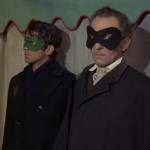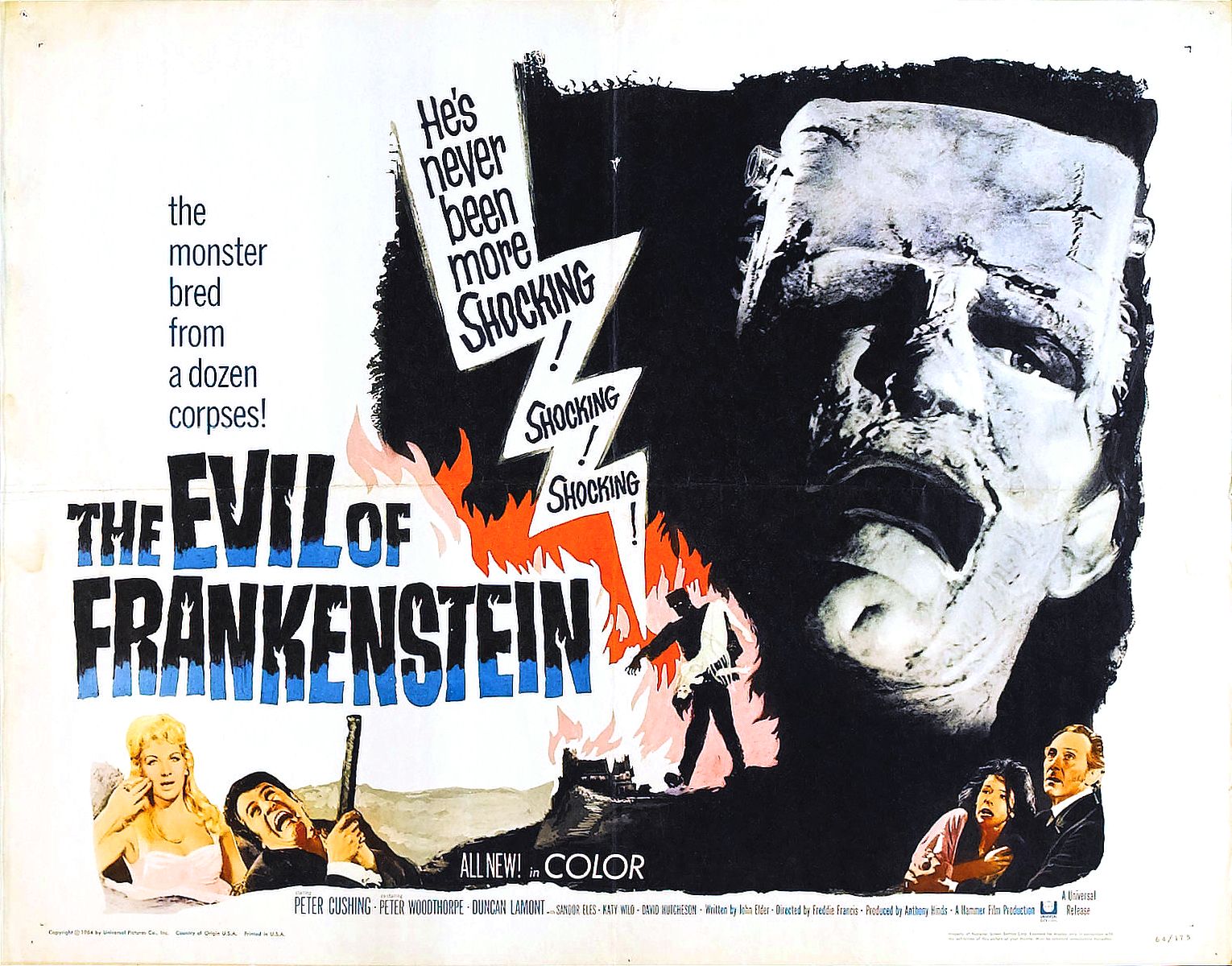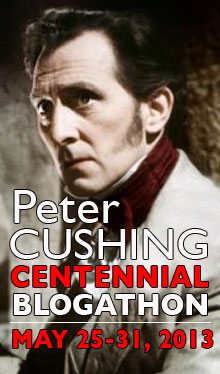
“The evil that men do lives after them.” — William Shakespeare, Julius Caesar
This is especially true for Baron Victor Frankenstein, who has a bad habit of bringing bad men back from the great beyond. Everyone needs a hobby, I suppose.
Welcome to Day Five of the
Peter Cushing Centennial Blogathon. Today, we’re going to take a look at what many consider to be the first reboot of Hammer Films’ Frankenstein franchise, The Evil of Frankenstein (1964). While there’s a definite change in direction, I’m not entirely sure continuity is cleanly severed, but we’ll get to that in a bit.
Along with the supposed break in continuity came a break in creative personnel as Evil would be the first Hammer Frankenstein film not written by Jimmy Sangster. Instead, Anthony Hinds, son of Hammer Films founder William Hinds, would pen the script under the pseudonym John Elder. Hinds had cut his teeth, so to speak, collaborating with Sangster on the script for The Brides of Dracula (1960) with Cushing reprising his Van Helsing role sans Lee’s title vampire. With Captain Clegg (1962) (U.S. title Night Creatures) in between, Evil would be the third time Hinds wrote for Cushing.
The second switch was unplanned, as Terence Fisher was set to direct this third installment in the franchise until a car accident left him unable to do so. Freddie Francis, already an Academy Award-winning cinematographer and longtime Hammer contributor, was brought in to helm the project. Given his background, it isn’t surprising that Francis brings some of James Whale’s influence into his compositions, in contrast to Fisher’s sparse, stagey arrangements.
Because of a distribution deal with Universal, Hammer Films were able to freely reference their series, and it is clear by creature design, laboratory sets, and promotional materials that this film was intended to take advantage of that and perhaps bridge the gap between the two Frankenstein film franchises. Hinds’ script also reinforces these connections with secluded mountain sets and mobs of angry villagers, both absent from the previous films largely because of budgetary constraints.
The Evil of Frankenstein (1964)
Our film opens with a body snatching that doesn’t quite work out as planned. The ubiquitous meddling priest succeeds in driving Victor Frankenstein and his assistant Hans (played by Cushing and Sandor Elès, respectively) from his village, destroying much of their laboratory in the process. While Victor’s human assistants traditionally let him down (from Paul in Curse to Karl and Margaret in Revenge), they have also saved him from the icy grip of death (Kleve in Revenge). This dependence on others will become a clear problem in Evil.
With their work demolished, Victor takes Hans back to his home village of Karlstaad, hoping to sell off some of his inheritance to fund further work. They find the chateau in ruins and looted clean. Disappointed and defeated, Victor relates the story of his exile.
This presents the biggest obstacle to including Evil in the continuity begun with Curse and Revenge. The title text of Curse clearly places the setting in Switzerland, a fact subtly reinforced during Victor’s exchange with Kleve in Revenge. Shelley’s Frankenstein is born in Geneva, Switzerland and educated at Germany’s University of Ingolstadt in Bavaria. Karlstadt [sic] is in the appropriately named Unterfranken region of Bavaria, Germany.
There are some interesting details in this flashback sequence. Firstly, Victor sets the events 10 years ago. In Revenge, Kleve indicates that it’s been a little more than 3 years since the death of Professor Bernstein.
While Sandor Elès is nearly 10 years younger than Francis Matthews, I do not take it as gospel that his Hans is not intended to be loyal assistant Hans Kleve. Hans was not present for the events of Curse, and in Revenge, he only helped with a pair of groundbreaking brain transplants, not the creation of life. There is also the suggestion that Kleve knew of Frankenstein’s work by reputation despite the Baron’s insistence on not publishing in Curse. Is it possible that the events relayed in flashback occurred sometime between the opening of Revenge and the later events in Carlsbrück? There’s certainly no other explanation given in Evil as to why Hans does Victor’s bidding.
Except Victor’s story fits neither the events of Curse nor the possibility proposed above. The monster, in flashback, attacks and consumes only livestock, and Victor is merely charged with assaulting police and heresy, sentenced to a brief imprisonment, a fine, and ultimately exile. Consider the source, however. Victor is hardly a reliable narrator and lying would be the least of his sins. There are even some who have looked at Shelley’s original novel as the ravings of the quintessential unreliable narrator, calling into question whether the monster exists at all.
Hiding behind masks during a village festival, Victor and Hans scope out the scene in Karlstaad. Victor sees one of his signet rings adorning the hand of the local Burgomaster, and it looks like he’ll be doing more revenging here than in The Revenge of Frankenstein. Victor cannot control his outrage, so he and Hans are forced to flee, a reaction a bit more exaggerated than brief imprisonment, fine, and exile would suggest.
They hide amongst the festivities, eventually evading authorities in a hypnotist’s exhibit. The hypnotist, Professor Zoltán (not to be confused with the Hound of Dracula), is as easy to rile as the Baron, and Zoltán ends up being taken into custody in their stead. Peter Woodthorpe is delightful as the puffed up carny and makes an effective foil for Cushing’s Baron. Woodthorpe followed up his role as Professor Zoltán by playing a nudie photographer in the Jimmy Sangster/Freddie Francis thriller Hysteria (1965) with Kiwi Kingston and as an ill-fated landlord in The Skull (1965) for Amicus, directed by Francis and starring Cushing, proving that he was quite adept at handling slimy, sleazy characters.
A second attempt to reclaim his valuables by Victor only serves to show that the constable who shot his creation in the flashback sequence has subsequently been promoted to Chief of Police (veteran actor Duncan Lamont, who returns to the series with a brief but important role in Frankenstein Created Woman). Victor and Hans are forced to continue their flight into the mountains. Here, they find the creature, frozen in ice.
Professional wrestler Ernie “Kiwi” Kingston plays the creature, made up to resemble the Karloff version more than a little. Kingston was an all-around accomplished sportsman, a successful amateur boxer, rugby player, and equestrian. In Germany, he would ride a horse to the ring and dismount onto the ring apron. While it might’ve been cool to see him ride down villagers as the monster, we’ll have to settle for a spearing, but you’ll have to wait for that.
and harnessed the tempestuous forces of nature to give it life!”
As if there was any doubt, this square-headed monstrosity cannot be the same creature played by Christopher Lee in Curse, since that one was dissolved in a vat of acid. Still, Victor is eager to get the frozen freak back to his ruined chateau laboratory and bring it back to consciousness. Once accomplished, the immobile thing will not obey his verbal commands.
Victor believes Zoltán to be the solution to his problem. Found to be practicing without a license, the hypnotist has been sentenced to that most popular of Karlstaad punishments, exile. Professor Zoltán has his own plans, however, and what follows might as well be called The Revenge of Zoltán or The Evil of Zoltán. When Victor objects, a power struggle predictably ensues, with Zoltán ordering creation to kill creator.
Frankenstein keeps his monster at bay with an oil lamp, but Zoltán blocks the only path of escape. This is where the spearing comes in. The monster goes on a rampage, destroying the lab equipment and starting a raging inferno. Judicious application of chloroform just serves to make matters worse. Hans and a deaf-mute girl (as easily omitted from the film as from this synopsis) look on as the chateau explodes in a ball of fire, presumably consuming Baron Frankenstein and his monster. Hans pronounces the final verdict, “They beat you after all.”
Except we’ve got two more days and three more films, so it’s far from conclusive.
Despite my musings and suggestions, it is admittedly difficult to fit The Evil of Frankenstein into the Hammer Films Frankenstein chronology. The more interesting intellectual exercise, I think, is to examine the progression of Peter Cushing’s portrayal of the Baron, from murderous man-child to charitable curmudgeon to vengeful outcast. We’ll continue on this path tomorrow, when we discuss that time when Frankenstein Created Woman (1967). You wouldn’t want to miss that, would you?


















































